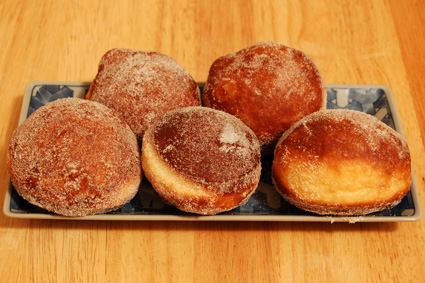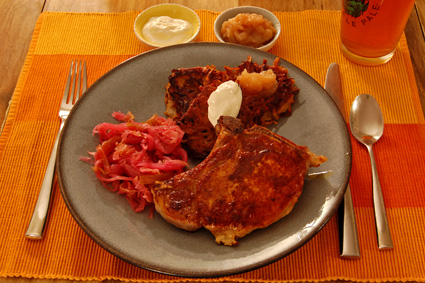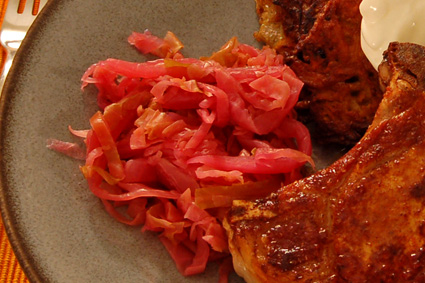Bagels. There's nothing that can quite match a crispy, chewy, still-warm-from-the-oven homemade bagel. Especially for a group of anxious baking students whose most pressing question is: "How soon can we eat them?"
The answer, of course, is as soon as you can pick them up without searing your fingers, though some of them decided not to wait that long. We made cinnamon raisin, onion, and poppyseed bagels last night, which were an understandable hit. Though I have to admit that I was taken aback by the one who admitted she'd never had a poppyseed bagel before.
BAGELS & PRETZELS
Baking 101 – Spring 2008
ABOUT BAGELS, PRETZELS, AND OTHER PARBOILED BREADS
Bagels and soft pretzels differ from more basic breads in one important aspect of the process: before baking, they are briefly boiled. It isn’t enough to cook them entirely, but works to develop that ideal shiny, chewy crust. Traditional bagels are also often made with less water than traditional bread doughs and given a long rise, making for a stiff dough that produces a dense interior. Modern mass-produced bagels – from the late 20th century on – usually use a short rising time followed by a steaming and baking process that produces a light, soft ring of bread that lacks the traditional crust and texture.
One essential for chewy bagels is a high-protein bread flour. The traditional texture needs lots of gluten, and thus good flour and effective kneading are necessary. It’s really a matter of taste, however, so knowing how it works lets you make bagels just the way you like them. Both bagel and pretzel recipes tend to include a small amount of sweetener, such as brown sugar, molasses, or malt syrup, which has a negligible effect on texture and sweetness, but lends a hint of extra flavor.
BREAD FLAVORINGS
The options for flavoring breads are pretty much limitless. Since white flour and water leave a fairly blank canvas on which to experiment, the simplest path to take is to start adding other flavors that you like and that go together. A few general suggestions:You can add anything that’s small, like herbs, directly to the flour before adding the liquid to distribute evenly. Larger chunks should wait until the dough has been kneaded, because they can make that process more difficult; add them in at the end of kneading, taking a minute to ensure they’re spread throughout the dough. Flavoring elements can also be added at any point when the dough is being worked prior to baking, or even rolled into a spiral layer inside the loaf just before it goes in the oven.
- Liquids. You can replace part or all of the water in any bread recipe with just about any other liquid you like, as long as you keep in mind the effects it may have on the texture. Most liquids will have a tenderizing effect, due to the proteins, sugars and acids in them, but do a wonderful job of making any bread more flavorful. Milk, beer, juices and even a small addition of olive oil – as in focaccia or ciabatta – will work in most cases.
- Herbs and spices. Small particles, such as ground spices, will have little to no effect on the texture of a bread, but can add a great deal of flavor. Even larger particles, such as caraway seeds and rosemary needles, won’t have a significant effect, and can be added without worry; by the time they would begin to have an effect on the bread, the flavor would be overwhelming. Different herbs and spices have different intensities, so start small. For strongly-flavored herbs and spices, start with a limit of a teaspoon per 3 cups of flour; for those that are milder, you can try up to a tablespoon for starters. Until you have a few batches under your belt, use a light touch. Too much or too many flavors in one loaf can make you feel like you’re eating potpourri.
- Chunks. All sorts of things can be incorporated into a dough for extra flavor, and large pieces are no exception. They will have the effect of making the loaf denser. They interfere with the gluten network by simply getting in the way, and enough chunks can act as dead weight counteracting the expanding gases in the loaf. Just about anything you might eat with bread can go inside it, as long as the pieces aren’t too large – less than ½ inch – and the total amount doesn’t exceed a cup per 3 cups of flour. Some good examples might be: a combination of raisins and chopped walnuts; chopped onions softened in butter; or a mix of grated cheeses.
THE BOILING STAGE
After the bagels or pretzels have been shaped and rested, they’re boiled briefly on both sides before baking. Use a large pot, bringing the water to a vigorous boil, and make sure that you don’t add too many bagels at once. They shouldn’t touch. Pretzels, due to their shape, take up the most space, and require several batches. After boiling, drain on a rack before salting or topping, then bake.
Boiling gelates the starches on the surface and causes the interior to puff up. After draining and topping, they bake in a moderately hot oven to brown the exterior by the time the interior is finished baking. In the oven, the starches on the surface form a thick crust; it limits the bagel or pretzel from expanding much further, keeping the interior dense and chewy. Pretzels are sometimes boiled in water with baking soda added; this helps create a dark brown exterior.ONION BAGELS
Adapted from How to Cook Everything
Makes eight to twelve bagels
INGREDIENTSDIRECTIONS
- 3-½ cups bread flour, plus more as needed
- 2 teaspoons salt
- 1 teaspoon instant yeast
- 2 Tablespoons brown sugar, molasses, malt syrup, or maple syrup
- 1-¼ cups water, room temperature, plus more as needed
- ½ cup minced onion, plus another teaspoon for topping
- 1 Tablespoon butter or oil
NOTES
- Saute the ½ cup onion in butter or oil over medium heat until softened, about ten minutes. Set aside to cool. Meanwhile, thoroughly mix together the flour, salt and yeast in a large bowl. In another bowl, mix together the water and sugar until completely dissolved.
- Mix together the flour mixture and the water with a wooden spoon until combined. Turn out onto a lightly floured board and knead until smooth and elastic. The dough should remain just slightly tacky, but not wet. Add the cooked onion and knead for another minute to distribute it evenly. Transfer to a bowl, cover with plastic wrap, and let rise until doubled, about 2 hours.
- Turn back out onto a lightly floured surface and punch down gently. Cover and rest for 10 minutes. Cut into eight to twelve equal-sized pieces – whether you want large or small bagels – and roll each into a ball. Poke a hole through the center and stretch into a bagel shape. Cover and let rise for another 30 minutes.
- Bring a large pot of water to boil, and preheat the oven to 400° F. Without crowding, drop the bagels into the water one at a time. Boil for one minute on each side, then remove to a rack to drain. Repeat with as many batches as necessary.
- Lay the bagels on a greased or non-stick baking sheet. Brush or spray the bagels with a little water and top with the remaining teaspoon of minced onion. Spray the inside of the oven with water to create steam and slide the baking sheet inside. Bake 5 minutes, then spray the oven again. Bake another 18 to 20 minutes, or until the bagels are nicely browned.
- Omit the onion for plain bagels; replace with ½ cup raisins and ½ teaspoon of cinnamon for cinnamon-raisin bagels.
- For poppy seed, sesame seed, or other sorts of toppings, just brush or spray the tops with water and sprinkle on the desired amount before baking.
SOFT PRETZELS
Makes eight to twelve pretzels
INGREDIENTSDIRECTIONS
- 4 cups bread or all-purpose flour
- 1 Tablespoon brown sugar
- 1 Tablespoon kosher salt, plus more for topping
- 1 teaspoon instant yeast
- 1 ½ cups water
- Mix together the flour, brown sugar, salt and yeast in a large bowl. Add in the water, stirring to make a smooth dough. Turn out onto a floured board and knead until the dough is smooth and elastic. Transfer to a bowl, cover, and let rise for about one hour.
- Divide the dough into twelve equal pieces. Roll each out into a long cylinder, then twist into a pretzel shape. Keep the dough covered when not working it to prevent it from drying out. Set each shaped pretzel on a baking sheet dusted with cornmeal, cover, and allow to rise another half hour.
- Preheat the oven to 425° F. Bring a large pot of water to a boil. Being careful not to crowd them, add the pretzels to the water and boil for one minute on each side. This may take four or more batches, depending on the size of your pot and your pretzels. Transfer the boiled pretzels to a rack to drain.
- Arrange the pretzels on a baking sheet dusted with cornmeal. Spray or brush lightly with a little water and sprinkle with kosher or coarse salt. Bake for approximately 20 to 25 minutes, until golden brown. Cool on a rack.




